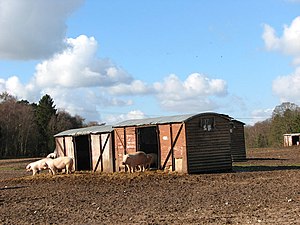
A farrowing hut is a shelter for swine (pigs) when giving birth.
It serves to keep the cold and wind out, and provide a relatively clean and protected place for the birth and for the young piglets.
Design factors[edit | edit source]
It should not be too heavy to move if needed - e.g. if a tractor is used on the farm, it should not be soo heavy that the tractor cannot pull it.
It should be strong enough that the floor is not damaged by the swine's weight, and if it leans against the wall, the wall should not break.
See also[edit | edit source]
- Swine
- LCA of Pig Farming
- Animal shelters
External links[edit | edit source]
- Building a Farrowing Hut - richsoil.com article with pictures of a farrowing hut in various stages of construction.
- farrowing hut - permies.com forum thread for questions on farrowing huts.